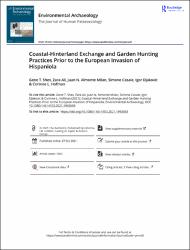| Abstract: | This study analyses zooarchaeological material recovered from the late precolumbian site of El Flaco (AD 990–1450), northern Dominican Republic. The faunal assemblage from this inland settlement demonstrates terrestrially focused modes of faunal exploitation but with some resources obtained from coastal ecosystems, such as mangrove forests, sandy-bottom, and reefs, which are located approximately 20 km to the northwest. This study establishes last occurrence dates for extinct taxa; examines the spatial distribution of fauna; explores modes of food procurement; and the effects of agricultural activities on local fauna by investigating animal remains from three excavation units. A diachronic study of animal remains from one artificial mound demonstrates changing patterns in resource exploitation, such as an increasing consumption of land crab over a roughly 100-year period. This study follows previous research that examined the isotope ecology of endemic species from El Flaco that indicates some hutias were possibly scavenging or being fed cultivated plants.
|
| Author(s): | Shev, Gene T.
Ali, Zara
Almonte Milan, Juan N.
Casale, Simone
Djakovic, Igor
Hofman, Corinne L.
|
| Date: | 2021
|
| Published: | Environmental Archaeology, 1-22
|
| Citation: | Shev, G. T., Ali, Z., Almonte Milan, J. N., Casale, S., Djakovic, I., & Hofman, C. L. (2021). Coastal-hinterland exchange and garden hunting practices prior to the European invasion of Hispaniola. Environmental Archaeology, 1-22. Recuperado de:
|
| URI: | https://bvearmb.do/handle/123456789/2727
|


